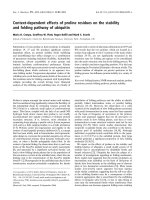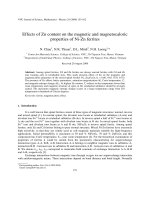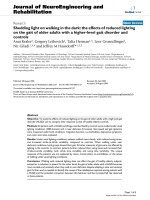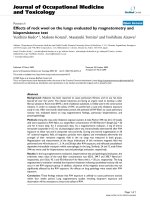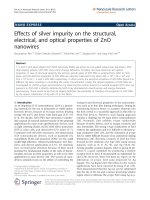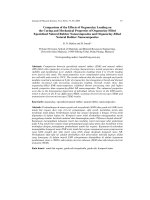Clinical features and effects of intravascular intervention of expanded aneurysm on the broken tentorium
Bạn đang xem bản rút gọn của tài liệu. Xem và tải ngay bản đầy đủ của tài liệu tại đây (132.37 KB, 7 trang )
Journal of military pharmaco-medicine no9-2018
CLINICAL FEATURES AND EFFECTS OF INTRAVASCULAR
INTERVENTION OF EXPANDED ANEURYSM ON
THE BROKEN TENTORIUM
Nguyen Duy Thanh1; Nguyen Hung Minh2; Vu Van Hoe2
SUMMARY
Objectives: To describe the clinical features and effects of intravascular intervention of
expanded aneurysm on the broken tentorium. Subjects and methods: Cross-sectional
descriptive study of 65 patients, who were diagnosed with expanded aneurysm on the broken
tentorium at 115 People’s Hospital from January 2011 to August 2017. Results: The most
common age was from 40 to 60 years old (49.2%). Women had a higher incidence of disease
than men (66.2%); for prevalence of high blood pressure, clinical symptoms included sudden
headache of 98.5%, vomiting of 56.9% and nausea of 49.2%, meningitis of 69.2%, sensory
impairment of 43.1%, seizures of 3.1%, focal neurology of 35.4%, drooping eyelid of 62% and
language disorders of 9.2%. Clinical symptoms at the time of hospitalization: 12.3% for
Hunt-Hess level I, 46.2% for level II, 35.4% for level III and 6% for level IV. Treatment of
expanded aneurysm on the broken tentorium with coils and insertion ball had 29 cases (45%),
obstruction with coils and stents had 34 cases (52%) and change in flow had 2 cases (3%).
Total obstruction was 87%, partial obstruction was 5%, change in flow was 3% and failure was
5%. Right ventricle dilatation with VP shunt was 1 case, pneumonia was 9 cases and residual
aneurysm was 1 case. These results were assessed in Glasgow, positive at 71%, negative at
25% and mortality at 5%. According to Hunt-Hess I - III, 46/65 patients were positive at 71.5%,
and Hunt-Hess IV - V were negative at 4.6%.
* Keywords: Intracranial aneurysm; Hemorrhagic meningine; Clinical features; Intravascular
intervention.
INTRODUCTION
Intracranial aneurysm is a common
system of cerebral arteries. Intracranial
aneurysm accounted for 1 to 8% [5] of
the population, most of the intracranial
aneurysms were detected after they had
broken. The rupture of the intracranial
aneurysm was a type of stroke with a
severe neurological disease, rapid and
complex progression, causing many
complications, sequelae as well as high
mortality. The rupture of the intracranial
aneurysm usually occurred suddenly,
severe headache, with or without meningeal
signs and local or total neurological
dysfunction. After rupture, about 10% of
patients died before being admitted.
The number of surviving patients with
primary bleeding was conservative, and
the recurrent bleeding was the main cause
of death, especially in the first two weeks.
1. 115 People′s Hospital
2. 103 Military Hospital
Corresponding author: Nguyen Duy Thanh ()
Date received: 19/09/2018
Date accepted: 21/11/2018
172
Journal of military pharmaco-medicine no9-2018
In fact, the rupture of intracranial aneurysms
was a tragedy for patients, families and
society. Therefore, the rapid diagnosis,
timely intervention and removal of the
intracranial aneurysms from the brain
circulation cycle by intravascular intervention
to seal the intracranial aneurysms with coils
(coil) to prevent patients from a serious
surgery to open the skull bulging the
intracranial aneurysms was a matter of
concern in connection with our topic. The
aims of this study were: To describe the
clinical features and effects of intravascular
intervention of expanded aneurysm on the
broken tentorium.
SUBJECTS AND METHODS
1. Subjects.
Patients diagnosed with expanded
aneurysm on the broken tentorium were
treated at 115 People's Hospital from
January 2011 to August 2017.
* Criteria for selection:
All patients with the expanded aneurysm
on the broken tentorium were diagnosed
clinically. Patients treated with intravascular
intervention at 115 People's Hospital.
Clinical classification of Hunt-Hess I, II, III.
Obstruction of aneurysm with coils and
stents across the neck for spherical
aneurysm (aneurysm/neck ratio < 1.5) [2].
Congestion of diamond aneurysm and
giant aneurysm. Patients and their families
agreed to treatment.
* Criteria for exclusion:
Patients diagnosed with the rupture of
the intracranial aneurysm on the tentorium
were treated surgically. Patients were
diagnosed with the rupture of the intracranial
aneurysm on the narrow neck. Patients
with severe medical and clinical illnesses
of Hunt - Hess five, did not accept this
treatment method.
2. Methods.
Uncontrolled cross-sectional clinical
descriptive study.
* Steps: Epidemiology, clinical features
of the ruptured intracranial aneurysm,
intravascular intervention, complications
after intervention and treatment results.
RESULTS AND DISCUSSIONS
1. Epidemiology.
* Age: The majority of patients between
40 - 60 years of age (30 patients),
accounted for 46.2%, more than 60 years
of age (32 patients) accounted for 40.2%
and less than 40 years of age (3 patients)
accounted for 4.6%, comparing with some
authors: Nguyen The Hao [1], Nguyen Son [2],
L. Pierot [6], there was no difference,
almost 40 - 60 years.
* Gender:
In our study, women accounted for
86.2% (56 patients), and men accounted
for 13.8% (9 patients). Comparing with some
authors: Nguyen The Hao [1], Greenberg
[5], Kassell [7], there was no different
about gender. But in our study, the rate of
women was important, perhaps our study
is not enough.
173
Journal of military pharmaco-medicine no9-2018
2. Clinical features of the ruptured
intracranial on the tentorium.
* Medical history:
26 patients (40%), less than in the study
by Nguyen Thi Kim Lien (70%) [4]. It can
be explained that only a few of patients in
city can go to the hospital early before
complication.
* Clinical symptoms at onset:
Figure 1: Medical history distribution.
Patients
with
a
history
of
hypertension were 43 patients (66.2%),
9 patients with a history of hemorrhagic
meninge (13.8%), 20 patients with no medical
history (30.8%) and 8 patients with other
medical history (12.3%). The majority of
patients in our study had history of
hypertension. In comparing with the other
authors like: Nguyen Son 53.8% [2],
Le Van Thinh 56% [3]. There were no
difference.
* Time from onset to admission:
The fastest time was 24 hours and the
latest time was 30 days. Average time
4.48 ± 6.34 days (median: 2 days). In our
study group, 26 patients (40.0%) were
hospitalized for the first 24 hours,
20 patients (30.8%) were hospitalized for
2 - 4 days, 11 patients (16.9%) were
hospitalized for 5 - 9 days and 8 patients
(12.3%) were hospitalized for more than
10 days. It was shown that the rupture of
the intracranial aneurysm was progressive
and sudden. In first 24 hours, there were
174
The two most common symptoms of
hemorrhagic meninge were sudden headache
in 64 patients (98.5%), vomiting in 37
patients (56.9%); nausea: 32 patients
(49.2%); disorder of autonomic nervous
system: 6 patients (9.2%); convulsion:
2 patients (3.1%) and drooping eyelids:
4 patients (6.2%). Our results were
consistent with studies by Nguyen Son
(90.91%) [2], Nguyen The Hao (83.5%) [1],
Le Van Thinh (98.0%) [3].
* Clinical symptoms at admission:
In our study group, meningiomas
accounted for a majority (45 patients =
69.2%), 28 patients (43.1%) with disorder
of consciousness perception and 23 patients
(35.4%) with focal neurological syndrome;
blood pressure ≥ 150 mmHg: 23 patients
(35.4%); polio III: 4 patients; signs of focal
neuropathy: 23 patients (35.4%); hemiplegia:
20 patients; language disorder: 6 patients
(9.2%) and stiffness: 45 patients (69.2%).
* Clinical levels at admission according
to Hunt-Hess:
61 patients (93.8%) hospitalized with
clinical levels from 1 to 3, 4 patients (6.2%)
with level 4. In our study, Hunt-Hess level
4 and 5 was majority in the comparing
with studies by Yasargil (10.7%) [8], Heros
(19.6%) [9], maybe the patients with
hemorrhagic meninge were late hospitality.
Journal of military pharmaco-medicine no9-2018
3. Intravascular intervention.
In our study group, there were 36
patients (55.4%) with stent obstruction
and 29 patients (44.6%) were supported
by insertion balls using coils blockage of
blood vessels; neck stent: 34 patients;
stent (change in flow): 2 patients.
57 patients (87.7%) with intracranial
aneurysm were intervened with total
intravascular obstruction, 3 patients (4.6%)
with partial intravascular obstruction,
2 patients (3.1%) with change in flow,
3 patients (4.6%) with failure.
4. Incidents and complications after
intervention.
* Complications after intervention:
Incidents after intervention in our study
group had 1 patient (1.5%) with ventricular
dilatation, 1 patient (1.5%) with residual
aneurysm and 9 patients (13.8%) with
pneumonia.
5. Treatment results.
We monitored and re-examined all patients
(100%). Our follow-up time occurred until
all of them were discharged from the
hospital
* Interventions relevant to patient age according to GOS:
Table 1: Correlation between age groups and patients.
GOS
Less than 55 years of age, n (%) ≥ 55 years of age, n (%)
Total n (%)
Very good (level V)
15
71.4
18
40.9
33
50.8
Good (level IV)
4
19.0
9
20.5
13
20.0
Average (level III)
2
9.5
10
22.7
12
18.5
Negative (level II)
0
4
9.1
4
6.2
Mortality (level I)
0
3
6.8
3
4.6
Total
21
44
p value
65
0.008
We found that the negative results were higher in the old age group, the clinical
findings after intervention and age were statistically significant with p = 0.008 (< 0.05).
* Interventions and pre-intervention status:
Table 2: GOS findings and clinical pre-intervention status (Hunt-Hess clinical scale).
Clinical pre-intervention status
Level 1 - 3
Levels 4 and 5
Total
Very good result
39
0
39
Good result
6
2
8
Average result
1
14
15
Negative result
0
3
3
Total
46
19
65
p value
< 0.001
We found that the negative results were very common in patients with Hunt-Hess 4
and 5. Clinical conditions and results after intervention were statistically significant with
p < 0.001.
175
Journal of military pharmaco-medicine no9-2018
Table 3: Results, intervals of intervention, and clinical conditions upon admission.
Clinical level
(Hunt-Hess)
Interval
≤ 4 days
5 - 10 days y
> 10 days
Average
Level 1 - 3
22
6
34
10.56 ± 7.87
Level 4 - 5
0
2
1
8.33 ± 2.31
Total
22
8
35
10.46 ± 7.71
p
0.012
0.649
We found that no correlation between intervals of intervention and clinical conditions
upon admission.
Table 4: Results, intervals of intervention, and clinical conditions before intervention.
Clinical level before
intervention
Interval
≤ 4 days
5 - 10 days
> 10 days
Total
Very good result
11
4
24
39
Good result
3
2
3
8
Average result
8
0
7
15
Negative result
0
2
1
3
Total
22
8
35
65
p
0.024
We found that correlation between intervals of intervention and clinical conditions
before intervention was found with p = 0.024. Clinical condition as light, the ability
to recover better results consistent reporting Hunt-Hess (1968), with clinical status
Hunt-Hess III survival rate of 50%, Hunt-Hess IV, V, (2009), the rate of good recovery
with Hunt-Hess I-III accounted for 83%, the group IV-V accounted for 56%, and
mortality in group I - III accounted for 5.3%, and Hunt-Hess IV - V accounted for
22%. According to Bracard (2002) [10], evaluating the results of intravascular
interventions of 80 patients with clinical heavy status of Hunt-Hess grade IV, V showed
the rate of good recovery accounted for 52.5%, with 37.5% of mortality in the first
6 months. Major cause of death from bleeding initial consequences in the group V and
vasospasm with the group IV.
176
Journal of military pharmaco-medicine no9-2018
* GOS-based assessments:
Table 5: GOS-based intravascular interventions,
GOS
Number of patients
Percentage (%)
1
3
4.6
2
4
6.2
3
12
18.5
4
13
20.0
5
33
50.8
Total
65
100.0
In this study, very good results (level IV - V) had 46 cases (70.8%), bad results
(level II-III) had 16 cases (24.7%), mortality had 3 cases (4.6%).
* Correlation between GOS at the time of discharging from the hospital and Hunt-Hess:
Effective clinical assessment at the time of discharging from the hospital by Glasgow
outcome on the basis of Hunt-Hess scale.
Table 6: Hunt-Hess-based clinical results.
Progression by Glasgow
Hunt- Hess
IV - V (positive)
II - III (negative)
I (mortality)
n
%
n
%
n
I - III
46
100
70.8
16
100
24.6
0
IV - V
0
0
3
46
16
3
p
%
100
Total
n
%
62
95.4
95.4
3
4.6
65
100
< 0.001
(Fisher-based verification)
The clinical results at discharge by Glasgow outcome in our group was positive
at 70.8%, negative at 24.6%, and mortality at 4.6%. The difference between the
positive group and the negative group was statistically significant with p < 0.001.
Hunts-Hess I - III had 46 out of 62 patients who were discharged and assessed
positively at 70.8%, Hunt-Hess IV - V had 3 out of 3 patients who died. The lower the
Hunt-Hess scale was at admission, the better the results were at discharge. In this
study group, the mortality rate was found to be Hunt-Hess IV - V. This difference was
statistically significant (p < 0.001).
177
Journal of military pharmaco-medicine no9-2018
CONCLUSION
Through our study of intravascular
intervention for 65 cases of expanded
aneurysm on the broken tentorium at the
Neurology Department of the 115 People's
Hospital, the following conclusions were made:
* Clinical features:
- The most common age group was
40 - 60 (49.2%). Women had a higher
incidence of disease than men.
- High blood pressure accounted for 66.2%.
treatment, in many cases, this method
should be the first choice, especially
where the aneurysm is not favorable for
surgery, the older patients are more risky.
REFERENCES
1. Nguyễn Thế Hào. Nghiên cứu chẩn đoán
và điều trị phẫu thuật chảy máu dưới nhện do
vỡ túi phình hệ động mạch cảnh trong. Luận án
Tiến sỹ Y học. 2006.
2. Nguyễn Sơn. Nghiên cứu lâm sàng,
chẩn đoán hình ảnh và điều trị vi phẫu thuật
kẹp túi phình động mạch não trên lều đã vỡ.
Luận án Tiến sỹ Y học. Học viện Quân y. 2010.
- Common clinical symptoms included:
Sudden headache, vomiting and nausea
meningitis, sensory impairment, seizures,
focal neurology, drooping eyelid and
language disorders.
3. Lê Văn Thính, Lê Đức Hinh, Nguyễn
Chương. Một số nhận xét lâm sàng của chảy
máu dưới nhện. Công trình nghiên cứu khoa
học Bệnh viện Bạch Mai. 1996, tr.125-130.
- Clinical conditions at admission: 12.3%
for Hunt-Hess level I; 46.2% for level II;
35.4% for level III and 6.2% for level IV.
4. Nguyễn Thị Kim Liên. Các yếu tố tiên
lượng khi nhập viện sau xuất huyết dưới nhện
tự phát. Y học Việt Nam. 2004, tr.13-19.
* Treatment results:
- Interventions in the study group:
Treatment of expanded aneurysm on the
broken tentorium with coils and insertion
ball had 29 cases (44.6%), obstruction with
coils and stents had 34 cases (52.3%)
and change in flow had 2 cases (3.1%).
- Total obstruction was 87%, partial
obstruction was 4.6%, change in flow was
3.1% and failure was 4.6%.
- Right ventricle dilatation with VP shunt
was 1 case, pneumonia was 9 cases and
residual aneurysm was 1 case.
- The results were assessed on Glasgow
scale in our group, positive at 70.8%,
negative at 24.6% and mortality at 4.6%.
According to Hunt-Hess I - III, 46 out of 65
patients were positive at 71.5%, negative
and mortality of Hunt-Hess IV - V at 4.6%.
In general, this is a minimally invasive
178
5. Greeberg S.M. SAH and aneurysms.
Handbook of Neurosurgery. Thieme, New York.
2016, pp.1156-1209.
6. Pierot L, Cognard C, Spelle L et al.
Safety and efficacy of balloon remodeling
technique during endovascular treatment of
intracranial aneurysms: Critical review of the
literature. Am J Neuroradio. 2012, 33, pp.12-15.
7. Kassel N.F, Joner C.J, Haley C et al.
The international cooperative study on the timing
of aneurysm surgery. Part 2, Surgical results.
J Neurosurg Pediatr. 1990, 73, pp.37-47.
8. Yasargil M.G. Diagnosis and therapy of
cerebrovascular diseases. Schweiz Rundsch
Med Prax. 1990, 79, pp.3-8.
9. Heros R.C. Microneurosurgical management
of anterior choroidal artery aneurysms. World
Neurosurgical. 2010, 73, pp.459-460.
10. Bracar S et al. Endovascular treatment
of Hunt and Hess grade IV and V aneurysms.
AJNR Am J Neuroradio. 2002, 32 (7), pp.12321236.

